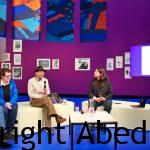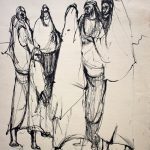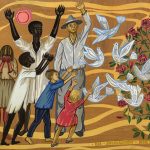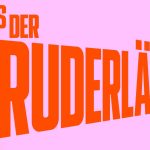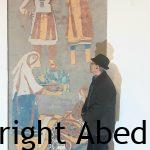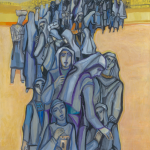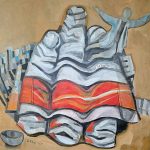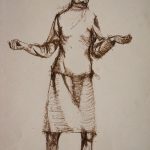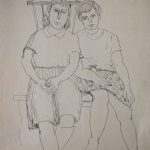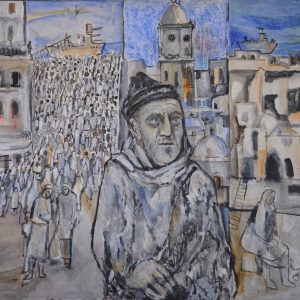
In his studio Abed Abdi, a leading Palestinian artist, is showing works of local residents. He also recalled wistfully his former neighbor, Emile Habibi.
The Work space of the artist Abed Abdi and his works are strongly tied to each other, and are connected to the city of Haifa where he was born and where he creates, and to the history of the Palestinian people.
Abdi, who is investing enormous efforts in creating opportunities gathering between art and the community and for that was awarded “The Notable of Haifa” Honorary title, now showing in two exhibitions: a retrospective of his work at the gallery in Umm al-Fahm (where on this Saturday an “open gallery talk” will take place), and the exhibit “Layers of Wadi Salib” at the “Piramida” Art Center in Haifa.
Ironically, Abdi’s Studio, One of the most important Palestinian artists in the Arab and the local art scene, is residing at HaTzionut [The Zionism] Avenue in Wadi Nisnas in Haifa. Abdi, 68, is a descendant of Abed al Haj, who served as mayor of Haifa in the 20s of the last century and was known for his many contributions to the city infrastructure and strengthening the Palestinian political conceptions.
Abdi, like other residents who lived there before 1948, knows the street named Al – Jabal (mountain road). After the establishment of Israel it was named Sderut Ha Um [The UN Boulevard] in recognition of the organization’s support for the establishment of the state. In 1975, in response to Resolution 3379 of the UN General Assembly declaring that Zionism is racism, the name of one of the main streets in the Arab neighborhood was changed to HaTzionut Avenue. In 2001 the Palestinian residents of Haifa signed a petition to restore the original street name but in vain.
In the heart of the storm, is a small orchard at the Evangelical Church Domain, where Abed’s studio resides and next to it his gallery. In the Studio space he has been creating for 25 years while in the gallery next to it, for years worked the author and journalist Emile Habibi. And for years the two collaborated: Habibi edited the newspaper “Al – Ittihad” and wrote in it and Abdi was the illustrator.
In the Yard stands a large bulletin board with art pictures made by the neighborhood children. Their scattered sculptures are also in the complex. “I turned the place into such that serves my works and in the same time the neighborhood and the local kids”, says Abdi. “I live with the feeling and responsibility that I have to display my art, but I also need to have a watching audience, an audience that can identify with arts with the acknowledgement that art is an integral part of the social, historical and political being.” Today, after three decades of activity in the city, “I feel I was able to evoke the awareness for arts in the Arab population”.
In many ways Abdi, along with few others, is filling the governmental shortage in this aspect. “The country has dozens of museums funded in part by the Ministry of Education and Culture, and within all there is not a single room dedicated to the local Palestinian heritage”, he says. He is working to change this situation, including ways to obtain funding to enable the Arab residents of Haifa to develop cultural and sports centers. The Municipal Museum, he says: “Agonizes me that the museum does not give true expression and representation to the population. This Phenomenon is neither healthy nor it represents the true face of art”.
During his art studies in Dresden, Germany, where he obtained his master’s degree, Abdi focused on murals and art in the open space. On his return to Israel he worked on this issue in Nazareth and managed a volunteering project to improve the public space in the city. In His gallery he showed his works alongside exhibitions of artists or his pupils. In the Compound in Wadi Nisnas he is directing “Arabelle” association for the promotion of art and within its framework he provides different activities and lectures.
The Environment in which he works always affected his work. On The structure of his studio, that was established in early last century, he says: “I’m happy that the building gives me the inspiration and that it’s from the days when the Palestinian population built their homes in this way”. He arrived here while working on the monument commemorating “Land Day” in Sakhnin with the artist Gershon Knispel.
For years, Aside creativity, Abdi taught in different places and held deferent activities like managing “The Festival of Festivals” held in Wadi Nisnas each December. But since he retired he attends the place every day and for prolonged periods.
“The studio is a place for work but is also a room for thought,” he says. “Muse is important, and probably here there’s a concentration of Muses. Perhaps this is the type of construction that brings inspiration to a historical affiliation”. He points to the arched ceiling: “on this people labored without crane and without cement”.
Abdi says that after years of work in graphics and illustration, which dealt with line harshness and the tension between the line and the area, he began to engage in the materiality of the place. “My family is in this city for about 250 years, and when I started to work the materiality of the rust, of iron and other objects that were lying around this area got in.” He points to a painting in the studio that is made of mixed media: painting, collage, assemblage, and in its center an oven that Abdi resembled as a pregnant woman’s belly. “Art from the ruins,” he says.
Abdi was born in Wadi Salib Haifa, and he and his family, like thousands of other people, were expelled and found themselves in a refugee camp. “A lot of inspiration came from the area of Wadi Salib,” he says, adding: “These days I do a lot of work with acrylic on canvas and using different materials. Less I am engaged in monumental works, since there are fewer budgets and more difficulties in raising funds. Moreover, I less want to work on erecting monuments and more invest my powers again over the same nostalgia that exists in fabrics used us when we lived in refuge hood”. His Family dispersed in refugee camps in Syria and Lebanon, and two years after the expulsion Abdi returned with his parents in the setting of family unification. “What is interesting is that the burlap fabric we used for cover and partitions – is back in my works “, he says. “The smell of burlap really takes me backwards”.
There is no other homeland
“I deal with the Jewish – Arab issue as an inseparable part of the Haifa scenery. In municipal Terms the civil service is supposedly given to the Palestinian residents of the city, but in terms of the country’s policy towards mixed populations the situation really worries me. In the reality I am dealing with as Palestinian I’m trying to manegel with the other out of solidarity. I also have no other homeland”.
By: Eli Armon Azulay, “Haaretz” newspaper (Hebrew edition), “Gallery” Section, 24.9.2010.
Source: “Haaretz” newspaper (Hebrew edition), “Gallery” Section, 24.9.2010.



